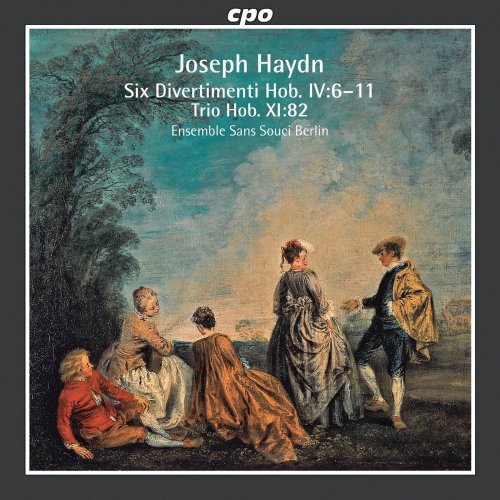Ensemble Sans Souci Berlin - Haydn: Six Divertimenti (2010)

Artist: Ensemble Sans Souci Berlin
Title: Haydn: Six Divertimenti
Year Of Release: 2010
Label: CPO
Genre: Classical
Quality: FLAC (tracks + booklet)
Total Time: 1:02:03
Total Size: 282 MB
WebSite: Album Preview
Tracklist:Title: Haydn: Six Divertimenti
Year Of Release: 2010
Label: CPO
Genre: Classical
Quality: FLAC (tracks + booklet)
Total Time: 1:02:03
Total Size: 282 MB
WebSite: Album Preview
1. Flute Trio No. 6 in D Major, Hob.IV:6: I. Adagio cantabile (02:54)
2. Flute Trio No. 6 in D Major, Hob.IV:6: II. Allegro (04:06)
3. Flute Trio No. 6 in D Major, Hob.IV:6: III. Tempo di Menuetto (01:47)
4. Flute Trio No. 7 in G Major, Hob.IV:7: I. Allegro (05:09)
5. Flute Trio No. 7 in G Major, Hob.IV:7: II. Adagio (03:33)
6. Flute Trio No. 7 in G Major, Hob.IV:7: III. Finale: Allegro (02:29)
7. Flute Trio No. 8 in C Major, Hob.IV:8: I. Allegro moderato (04:03)
8. Flute Trio No. 8 in C Major, Hob.IV:8: II. Poca adagio (02:11)
9. Flute Trio No. 8 in C Major, Hob.IV:8: III. Finale: Presto (02:01)
10. Flute Trio No. 9 in G Major, Hob.IV:9: I. Adagio (03:34)
11. Flute Trio No. 9 in G Major, Hob.IV:9: II. Scherzo: Allegro (01:19)
12. Flute Trio No. 9 in G Major, Hob.IV:9: III. Finale: Presto (01:19)
13. Flute Trio No. 10 in A Major, Hob.IV:10: I. Andante con expressione (05:16)
14. Flute Trio No. 10 in A Major, Hob.IV:10: II. Adagio (02:03)
15. Flute Trio No. 10 in A Major, Hob.IV:10: III. Tempo di Menuet (00:54)
16. Flute Trio No. 11 in D Major, Hob.IV:11: I. Allegro moderato (04:42)
17. Flute Trio No. 11 in D Major, Hob.IV:11: II. Adagio (01:42)
18. Flute Trio No. 11 in D Major, Hob.IV:11: III. Vivace (01:54)
19. Baryton Trio No. 82 in C Major, Hob.XI:82 (arr. for flute trio): I. Adagio (05:27)
20. Baryton Trio No. 82 in C Major, Hob.XI:82 (arr. for flute trio): II. Allegro (03:12)
21. Baryton Trio No. 82 in C Major, Hob.XI:82 (arr. for flute trio): III. Menuetto (02:19)
Haydn's small divertimenti aren't a compact, institutionally associated group like his works in most other genres; he wrote them over his entire career, for various reasons. The group of six divertimenti here (the program is rounded out by a transcription of an earlier baryton trio) were published in 1784, and they represent the fruits of Haydn's decision that if he couldn't beat the numerous pirates who were publishing his chamber works all over Europe, he might as well join them. They were written for two violins and cello and intended for an English publisher, who was cognizant of the large market for flute music in that country and specified flute, violin, and cello as an alternate instrumentation. The pieces work well with these forces, and some of them might even be more desirable than with the two-violin ensemble; they have a bit more heft than the divertimenti composed purely for domestic use at Esterháza, and the flute brings this out. Consider the finale of the Divertimento in G major, Hob. 4/7, which feels like a little symphony movement. Haydn builds these little works out of pieces like that, with some lovely slow movements, filling them out with repurposed dances and melodies from operas and the like that had never been heard outside of Esterháza. The result is a satisfying set of small pleasures to which the Ensemble Sans Souci Berlin, performing on instruments related to Haydn's era, are fully attuned; these are quiet, witty performances that do justice to these little-known works. CPO's engineers, working in a small theater in the town of Eitorf (near Cologne), deliver a natural, authentic sound environment.




![Betty Carter - The Music Never Stops (2019) [Hi-Res] Betty Carter - The Music Never Stops (2019) [Hi-Res]](https://www.dibpic.com/uploads/posts/2025-12/1765896843_bcmn500.jpg)
![Dave Bainbridge - ON THE EDGE (OF WHAT COULD BE) (2025) [Hi-Res] Dave Bainbridge - ON THE EDGE (OF WHAT COULD BE) (2025) [Hi-Res]](https://img.israbox.com/img/2025-12/18/7l4en830rpyaxdtr7izc3qrx6.jpg)
![The Mood Mosaic - The Sexploitation (Pulp Grooves From The Mondo Porno Vault) (2025) [Hi-Res] The Mood Mosaic - The Sexploitation (Pulp Grooves From The Mondo Porno Vault) (2025) [Hi-Res]](https://www.dibpic.com/uploads/posts/2025-12/1766131648_uhod8d4qn4msi_600.jpg)
![Frank Sinatra, Count Basie - It Might As Well Be Swing (1964) [2021 SACD] Frank Sinatra, Count Basie - It Might As Well Be Swing (1964) [2021 SACD]](https://www.dibpic.com/uploads/posts/2025-12/1766090910_scan-1.jpeg)
